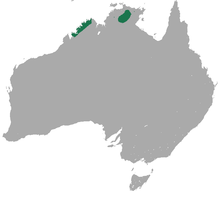Dwarf stone kangaroo
| Dwarf stone kangaroo | ||||||||||||
|---|---|---|---|---|---|---|---|---|---|---|---|---|
| Systematics | ||||||||||||
|
||||||||||||
| Scientific name | ||||||||||||
| Petrogale concinna | ||||||||||||
| Gould , 1842 |
The nabarlek ( Petrogale concinna ) is a bag species from the family of kangaroos (Macropodidae).
features
Together with Petrogale burbidgei, dwarf stone kangaroos are among the smallest representatives of the rock kangaroos and among the smallest kangaroos at all. They reach a head body length of 29 to 35 centimeters, in addition there is a 22 to 31 centimeter long tail. Their weight is 1 to 1.7 kilograms. Their short, silky fur is colored reddish-gray on the upper side, the underside is white-gray, the tail becomes darker towards the tip. As with most kangaroos, the hind legs are significantly longer and stronger than the front legs, the soles of the feet are provided with thick pads. Their change of teeth is unique among the bag mammals: behind the last normal molar there are further molars that break through when the previous one is worn down. The exact number of teeth is not known, there could be up to nine molars protruding one after the other.
distribution and habitat
Little stone kangaroos live in Australia , their range is divided into two parts. On the one hand, they occur in the Kimberley region in northern Western Australia , and on the other hand in the Top End in the north of the Northern Territory . Their habitat are rocky mountain regions.
Way of life
These kangaroos are nocturnal in the dry season and hide in crevices or caves during the day to go foraging at night. In the rainy season they are more active during the day. The food also changes with the season, so in the dry season they mainly eat ferns , while in the rainy season they tend to eat grass . The ferns have a strong abrasive effect on the teeth, which was probably the reason for the development of the unique teeth.
Mating can take place all year round. After a gestation period of around 30 days, the female usually gives birth to a single young. This spends its first months of life in the mother's pouch, it comes out for the first time at around 160 days and is independent at 175 days. Weaning is much more abrupt than with the other rock kangaroos.
Danger
Little is known about the endangerment level of the dwarf stone kangaroos. In some areas they are extinct, but they are common elsewhere. There is no information about the population trend or possible dangers, the IUCN lists the species under “too little data available” ( data deficient ).
Systematics
Due to the unique teeth and differences in the way of life, the dwarf stone kangaroo is sometimes listed in its own genus Peradorcas . However, two species of rock kangaroo , the short-eared rock kangaroo ( Petrogale brachyotis ) and Petrogale burbidgei are more closely related to the dwarf stone kangaroo than to the other rock kangaroos. In order not to let the rock kangaroos become paraphyletic , the dwarf rock kangaroo is now also included in this genus.
The populations in the two separate ranges are sometimes listed as subspecies of their own, but there are no morphological or genetic studies as to whether this separation is justified.
literature
- Ronald Nowak: Walker's Mammals of the World. Johns Hopkins University Press, Baltimore 1999, ISBN 0-8018-5789-9
Web links
- Information at Animal Diversity Web
- Petrogale concinna onthe IUCN Red List of Threatened Species . Retrieved May 21, 2009.
